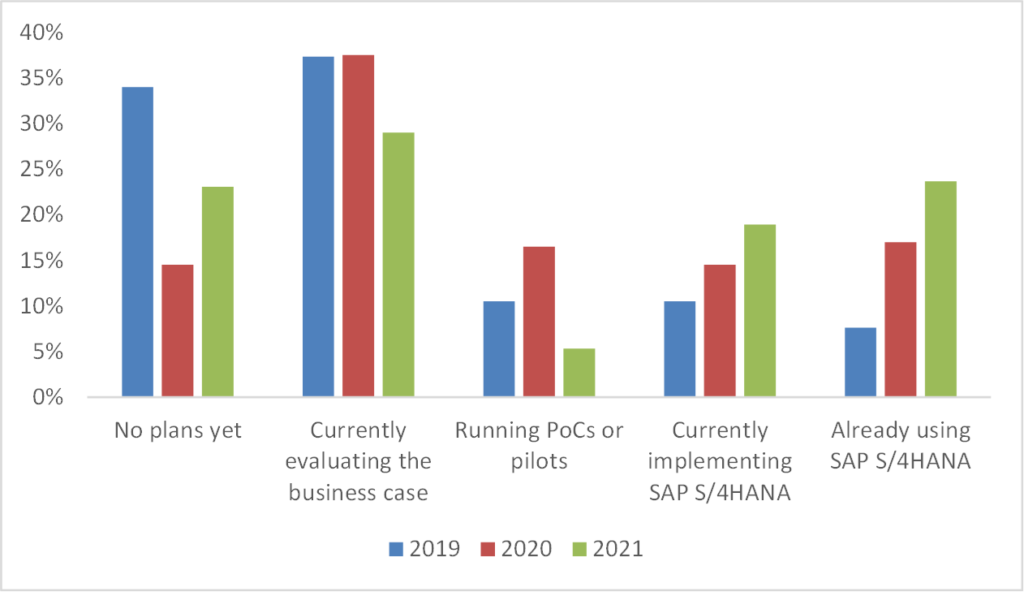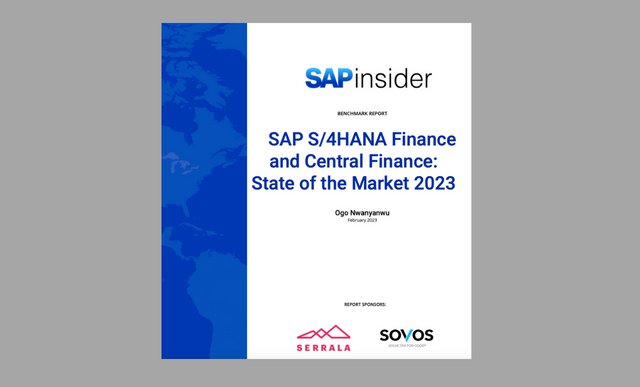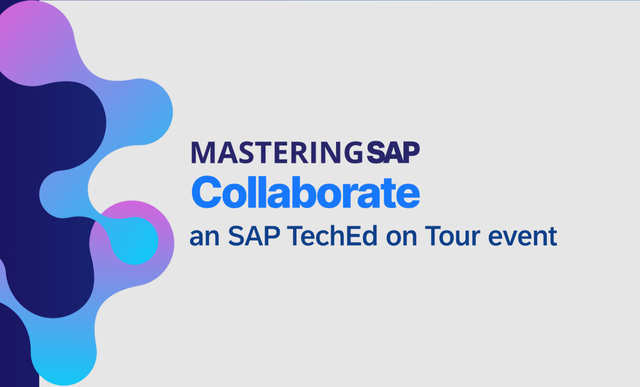SAPinsiders Shift Focus
SAP S/4HANA, the Cloud, and Central Finance Implementations
Meet the Experts
By Rizal Ahmed, Chief Content Officer, SAPinsider
The imperative to transform applications and landscapes is starting to accelerate as SAP customers explore and start their migrations to SAP S/4HANA and the cloud, finds SAPinsider’s latest research. In March, SAPinsider published our third annual report examining SAP customers’ plans for SAP S/4HANA, “SAP S/4HANA Migration Benchmark Report.” During May of this year, we also completed our third annual study, “SAP S/4HANA Finance and Central Finance: State of the Market 2021 Benchmark Report.” The results show that many organizations are entering the active evaluation stages now that the dust has settled from the past year’s disruption.
Companies are also embracing process standardization and efficiency as an important counterpart to their landscape and infrastructure renovation plans.
Explore related questions
After the Pandemic Halt, More Organizations Enter SAP S/4HANA Implementation Phase
Activity and interest in SAP S/4HANA are accelerating as companies reinvigorate their investments in SAP and overall technology. This conclusion continues to be reinforced across all of SAPinsider’s 2021 research. Our findings show that actual implementations are increasing over the past year. Companies are now leaving the evaluation phase and beginning their projects. This year’s study indicates that 42% of survey respondents have implemented or are in the process of implementing SAP S/4HANA. That’s a 10% jump over our 2020 findings. Those that are already using SAP S/4HANA rose from 17% to 24%, while those in the implementation phase went from 15% to 19% (see Figure 1).
Figure 1 – Where are SAPinsiders with their SAP S/4HANA Plans?

For those companies that are still waiting it out, the top impediment to progress has been COVID-19. Nearly half (49%) of our respondents report that the pandemic has had a significant impact on their SAP S/4HANA plans.
But now companies are ready to get back to business and start thinking about this potential move. While the SAP S/4HANA deadline for maintenance has been extended, many businesses know that it’s a complex multi-year project and that they need to get started sooner rather than later. SAPinsider research on SAP S/4HANA deployment finds that the average SAP S/4HANA project lasts 12-18 months, not including the business case.
Process Efficiency and Innovation Serve as the Foundation for Transformation Initiatives
Over the past year, it’s become clear that as organizations build out their transformation initiatives, the foundation of these efforts focuses on process efficiency, automation, and standardization. This came out loud and clear from all of SAPinsider’s early 2021 research.
According to our March SAP S/4HANA study, the top drivers shaping business and technology strategy continue to focus on re-engineering business processes and correcting legacy customization and inefficiency. Nearly half (45%) cited this as a top driver. This has been a constant obstacle and pain point for many organizations that limits visibility and innovation. “Our existing ERP system was outdated and hadn’t been updated in 11 years. We evaluated different possibilities and ended up choosing SAP S/4HANA. It met all our requirements, and the performance has been everything we need,” commented Ram Kolisetty, Director, Engineering for Dow Jones & Company.
Companies are combatting the pain of excessive customization and manual processes in several ways that blend both standardization and automation approaches. In our March study, not surprisingly, the number one strategy to support this top driver is adopting “best practice” business models, with 42% of respondents choosing this option (see Figure 2). In our May study focusing on SAP S/4HANA Finance, by far the leading strategy that respondents chose was to increase their investment in automation. Over half (56%) of SAPinsiders chose this as one of their most strategic priorities (see Figure 3).
Figure 2 — Top SAP S/4HANA Strategies

Figure 3 — Top Strategies to Address Finance Drivers

As the amount and complexity of transactions and processes grow, companies are looking to improve efficiency and free up their human capital for more strategic tasks. “We used to have a wide variety of disparate financial systems that we had to interconnect to create visibility. We did not have a single repository for data, and we were poorly automated. Over the last few years, we have spent time building out our automation capabilities so that we can streamline many of our routine, repetitive tasks and relieve our employees from these areas and have them focus on analytics and data to drive insights,” commented a process lead from a large health care company that we interviewed.
Behind this focus on process renovation and efficiency is the need to continuously support innovation and the changing needs and expectations of users. This priority was relatively new to the research but is gaining significant interest. The mandate to better support business users with innovative solutions earned nearly a third of responses (31%). The availability of solutions combined with the tech savviness of the average employee are driving up expectations. Users want experiences that are similar to what they are used to with mobile and web applications, and the patience for latency or limited visibility is wearing thin.
The speed with which businesses need to operate and adapt has also changed significantly with the recent pandemic shining a spotlight on the importance of adaptability and flexibility. This showed in the research as nearly half (47%) of the survey respondents said they were implementing new systems and processes to support evolving business changes and requirements. This was the top-cited business and technology strategy in the survey.
SAPinsiders Prioritize Investments in Transparency and Visibility
The need to have clear visibility into finance and operations is shaping both business and technology strategies. Our SAPinsider SAP S/4HANA Migration survey revealed that for 43% of respondents, modernizing their reporting and business intelligence strategy to provide faster access to business insights is their key strategy. This earned the second-highest response within the survey.
These results dovetail with our May SAP S/4HANA Finance and Central Finance: State of the Market Benchmark Report. In this study, we found that over half (53%) reported that financial reporting and dashboards represented their top pain point. This was a 12% increase over previous years. Likewise, analytics came out as the top investment that companies were focusing on in 2021. A majority (57%) said that resources would be allocated toward analytics as a strategic priority.
At the heart of many of the aforementioned is the inherent system and application complexity that arose in many organizations over the years. Numerous applications sprouted up haphazardly with little to no governance as it relates to customization, data integrity, and integration.
Solving system and process complexity was the top driver of business and technology strategies and investments, according to our May SAP S/4HANA finance study (see Figure 4). A majority of respondents (55%) said that the pressure to reduce the cost and complexity of finance and accounting was the most important external driver influencing their organization. This answer stood alone as it was 17% higher than the next most popular response, which was the demand for better planning and insights.
Figure 4 — Top Drivers of Your SAP S/4HANA Strategy

“Our antiquated systems are hindering decision-making because they don’t allow us to have visibility into our business,” complained a director at a food processing company we interviewed.
Many Consider Central Finance Deployment Options
In order to curb complexity and drive their finance transformation, many organizations are looking at Central Finance as a deployment option. Over one- third of respondents (38%) who have moved to or are considering SAP S/4HANA Finance will deploy using Central Finance, says our May research.
Many see Central Finance as not just a way to gradually migrate to SAP S/4HANA Finance but as a path to quickly enable transformation initiatives. A clear majority of those respondents who have or will deploy using Central Finance (79%) say that an expected benefit of following this deployment model relates to finance and business transformation.
Process centralization was the second-most important perceived benefit chosen by nearly half (49%) of our respondents. Many (42%) also see Central Finance as a catalyst for innovation adoption and acceleration. These findings show that the perception and expectation from Central Finance is clearly moving beyond just process efficiency and enabling a gradual transition to SAP S/4HANA.
Cloud Grows in Popularity as Both a Deployment and Solution Option
Cloud is a de-facto option that many companies are considering in conjunction with their SAP S/4HANA migration. Our SAP S/4HANA Migration Benchmark Report found that “deploying a flexible cloud-based or hybrid infrastructure that minimizes TCO and accelerates deployment of software instances in a compliant way” cracked the top three strategies organizations are deploying to support the above-mentioned drivers. This answer option came in at 41% of responses. In previous years of the study, this answer choice did not even crack the top five most popular strategies.
Cloud is being embraced throughout all its flavors from hyperscalers and infrastructure-as-a-service solutions, to increasing interest in specific software-as-a-service offerings. Our current June study on SAP S/4HANA deployment options finds that 67% of those in our survey are planning to deploy SAP S/4HANA in some sort of cloud. Nearly a quarter (24%) of respondents plan to use a hyperscaler in either a pure cloud or hybrid environment. Just under half (43%) will rely on a private cloud as part of their deployment.
Organizations know that they cannot compete with the managed providers and hyperscalers, such as Microsoft, Google, and Amazon, when it comes to investments in infrastructure. Many are looking to benefit from the economies of scale that hyperscalers provide while relieving themselves from management and upgrade burdens.
On the cloud solution front, we are seeing increasing evaluation and adoption of cloud-based finance applications covering everything from cloud-based planning and analytics through to performance management and even core ERP.
In our May “SAP S/4HANA Finance and Central Finance” study, the second-most popular solution being implemented is cloud-based analytic solutions, such as SAP Analytics Cloud. However, a majority plan to evaluate a host of finance and accounting cloud solutions this year. Those include cloud-based profitability and performance management (55%), as well as core cloud-based ERP, such as SAP S/4HANA on the cloud (54%) and cloud-based analytics (49%). These solutions represented three of the top five solutions that respondents are assessing in the coming year.
What Does This Mean for SAPinsider Executives?
Change and transformation are clearly accelerating for many organizations. Whether you have already started down that path or are still evaluating your options, here are a few guidelines for success:
Play devil’s advocate. The traditional norms of your organization may lead you to believe that a certain deployment option or cloud solution is not right for your enterprise. Go against the grain and at least explore scenarios and options that you normally would not consider. At the very least, you will expand your knowledge and perspective on different approaches. And you may find that the option you know the least about is the right one.
Double down on people, training, and communication. Business, technology, and solutions are evolving at a rate that we have not experienced before. All organizations need to expand their skill sets in areas such as SAP S/4HANA, the cloud, and automation. Train existing employees, assess your teams, and aggressively acquire the missing skill sets. And do not take for granted the process and business knowledge you have within the organization. Put innovative technology in their hands to create new knowledge and experiences that can lead your transformation.
Test early and often. Most executives and project leaders we spoke with said that you cannot underestimate testing when it comes to both the cloud and SAP S/4HANA transitions. The cloud enables you to reduce the complexity and accelerate testing and experimentation. Take advantage of these opportunities and work with your partners to explore scenarios that drive agility into testing processes so that you can learn and address challenges at a more rapid rate.
Link efficiency, standardization, and transformation initiatives. As most companies look to solve core business pain points, many of the success stories are looking at these opportunities to completely rethink their processes. Expand your perspective beyond just efficiency and cost cutting to consider what changes you need to make to core processes that will support new products and business models. Combine automation, standardization, and process rethinking at the outset, so that you are moving your projects beyond short-term objectives.









